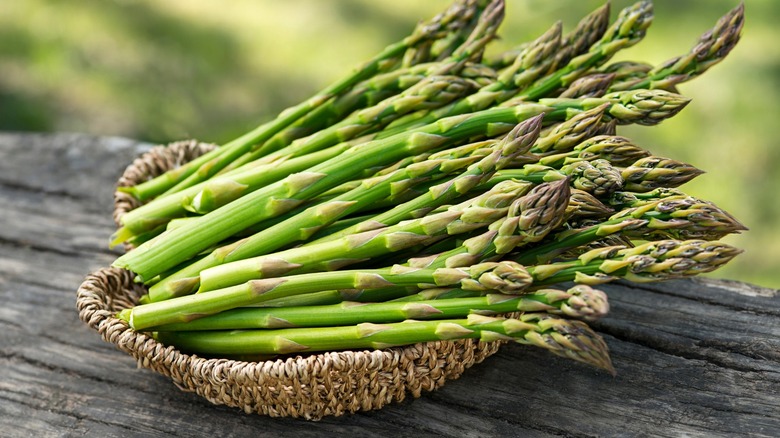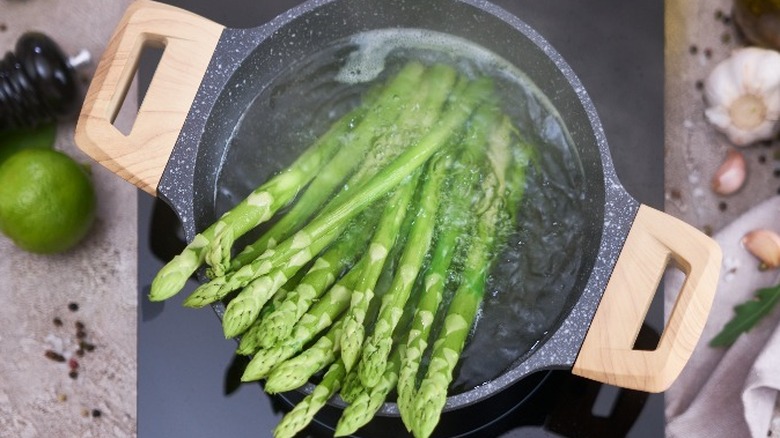Roman Emperors Were Strangely Fascinated By Asparagus
Ancient cuisine and its cultural context might often come across as mysterious and foreign, but every now and then, there's proof that some food traditions outlive the people who first enjoyed them. Take asparagus, for instance, the crunchy, slightly bitter stalk that humans have been gravitating towards for millennia due to its unique flavor and supposed medicinal properties. The ancient Roman elite, in particular, were huge fans of the plant, and you may even learn an asparagus recipe or two from studying their methods of preparation.
Most of the information on the cuisine of Roman antiquity comes from visual depictions found in archaeological findings, such as frescoes and mosaics that depict what went on during banquets at the time. Luckily for food historians, there's also the essential "De Re Coquinaria" ("On Cooking") cookbook, also known simply as "Apicius," a moniker attributed to its presumed author and compiler Marcus Gavius Apicius. This manuscript of recipes lends more insight into the world of ancient Roman cooking, which included fish sauce, flamingos, and, of course, asparagus.
Asparagus for Augustus
In Roman culinary practices, grains were the primary ingredients, with bread or porridge for those less wealthy occupying a central role in almost every meal. Legumes like dried peas, fava beans, and lentils also played an important role in protein consumption. Vegetables like lettuce and cabbage were more readily available than meat, but asparagus lived right alongside fish and pork as fare for the rich.
The first and most renowned Roman emperor, Caesar Augustus, had such a liking for asparagus that he is said to have organized military expeditions to find this vegetable in the wild, before having it transported to the Alps for preservation. That isn't to say that asparagus farming didn't exist, either, as agricultural records report asparagus cultivation more than one hundred years before Augustus was born. Additional evidence includes wall paintings in Pompeii that show asparagus bundles and an archeological asparagus bed found in Cambridge, England. Most famously, Augustus himself was quoted as announcing before an execution: "Velocius quam asparagi conquantur!" In English, that's: "Faster than cooking asparagus!"
Ancient Roman asparagus recipes
Augustus reportedly preferred his asparagus al dente, but "Apicius" recommended boiling the vegetable for some time before consumption. Translating for a 1936 edition of "Apicius," Joseph Dommers Vehling concluded that more specifically, the author was explaining that the chef should stand a bunch of asparagus upright in a vat of boiling water so that the stalks are submerged and the heads stick out just enough for the steam to cook them. That, at least, would certainly lead to a more al dente style fit for Augustus. His great-uncle, Julius Caesar, was known to have a preference for his asparagus luxuriously drenched in melted butter.
"Apicius" also listed a recipe for asparagus patina, a sort of baked mash that requires asparagus tips to be ground up in a mortar and pestle and then mixed with flavorings like fish sauce, oil, pepper, and herbs. In addition, there's also an extra-extravagant recipe for baking songbirds topped with an asparagus purée. While that may sound a little too out there, the ancient Roman obsession with asparagus proves the plant's remarkable flexibility in cooking and endurance in culture.



